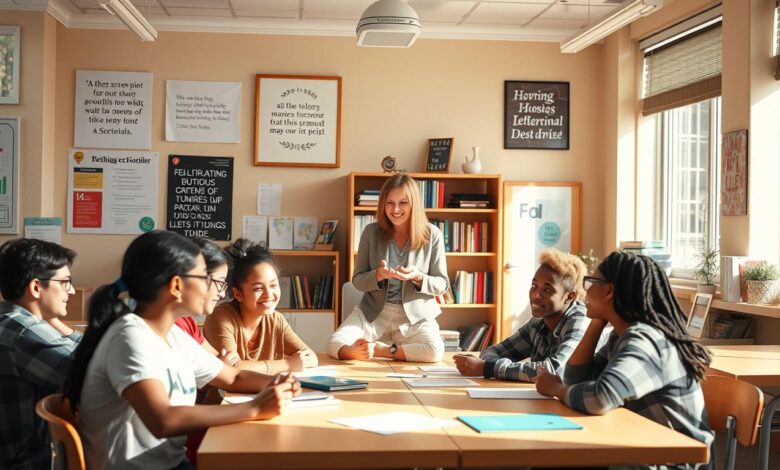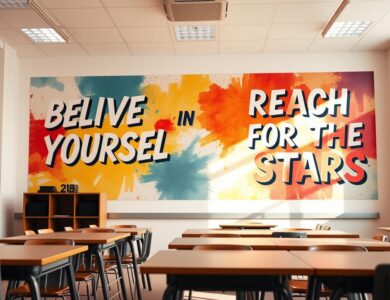Inspiring Student Motivation: Proven Techniques to Engage Learners in 2025

Engaging learners is key in education. When academic encouragement is done right, it boosts grades and makes learning fun.
Creating a supportive space is vital for learner engagement. Knowing what drives Student Motivation helps teachers craft strategies to spark interest.
This article will dive into effective ways to boost learner engagement. It aims to equip educators with the tools to make learning exciting and motivating.
The Science Behind Student Motivation
Understanding student motivation means exploring the psychological and educational theories that drive engagement. It’s key for teachers to know these theories. This knowledge helps them create strategies that meet the needs of all students.
Understanding Motivation Theories in Education
Motivation theories in education fall into two main categories: intrinsic and extrinsic. Intrinsic motivation comes from personal satisfaction in learning. On the other hand, extrinsic motivation comes from outside rewards and recognition. The Self-Determination Theory (SDT) highlights the need for autonomy, competence, and relatedness to boost intrinsic motivation.
Teachers can use these theories by giving students choices, setting challenges, and fostering a supportive learning space.
| Motivation Theory | Description | Educational Application |
|---|---|---|
| Self-Determination Theory (SDT) | Emphasizes autonomy, competence, and relatedness | Providing choices and challenges |
| Expectancy-Value Theory | Focuses on expectations and value of tasks | Highlighting relevance and utility |
Identifying Common Barriers to Engagement
Even with great efforts, barriers can still block student engagement. These include tasks that seem irrelevant, lack challenge, and a negative classroom atmosphere. Identifying these barriers is the first step to overcoming them.
Strategies like making lessons relevant, offering scaffolding, and promoting a growth mindset can help. These approaches can boost student motivation.
Harnessing the Power of Intrinsic Motivation
To truly inspire learners, educators must tap into the power of intrinsic motivation. This internal drive is what propels students to engage deeply with the learning material and persist in the face of challenges.

Fostering Curiosity and Personal Interest
One effective way to cultivate intrinsic motivation is by fostering curiosity and personal interest in the subject matter. Educators can achieve this by:
- Connecting lesson content to real-world applications
- Encouraging students to explore topics of their choice
- Incorporating hands-on activities and experiments
Developing Autonomy in the Learning Process
Giving students autonomy in their learning process is another crucial factor. This can be achieved by:
- Allowing students to set their own learning goals
- Providing choices in assignments and projects
- Encouraging self-directed learning
Building Competence Through Appropriate Challenges
Building competence is essential for maintaining intrinsic motivation. Educators should provide challenges that are appropriate for their students’ skill levels, ensuring that they are neither too easy nor too difficult. This can be done by:
- Offering scaffolding techniques for complex tasks
- Providing regular feedback on progress
- Adjusting the difficulty level based on student performance
By implementing these strategies, educators can harness the power of intrinsic motivation, leading to a more engaged and motivated student body.
Implementing Extrinsic Rewards Effectively
Extrinsic rewards, like praise or tangible incentives, can boost student motivation. They make learning activities more appealing, even when they’re not naturally interesting.

When and How to Use External Motivators
External motivators work best in specific situations. For example, they can help students get excited about new or tough topics. It’s crucial to use them wisely to avoid losing intrinsic motivation. Effective use means setting clear goals, giving immediate feedback, and slowly removing rewards as students become more interested in learning.
- Identify specific learning objectives that require extrinsic motivation.
- Choose appropriate rewards that are meaningful to the students.
- Establish clear criteria for earning rewards.
Transitioning from Extrinsic to Intrinsic Motivation
The goal is to make students motivated by their own interests. To do this, educators can use several strategies. One way is to help students see how learning connects to their interests or future goals. Another is to let students choose what they learn, making them feel more in control.
- Encourage students to set personal learning goals.
- Provide opportunities for students to explore topics of interest.
- Celebrate progress and achievements in a way that reinforces intrinsic motivation.
By knowing when and how to use extrinsic rewards, educators can create a balanced approach. This supports students in developing a lasting love for learning.
Cultivating a Growth Mindset for Academic Success
Having a growth mindset is key for students to do well in school and love learning. This mindset, introduced by Carol Dweck, means believing you can get better with effort and hard work. It helps students stay strong, take on tough tasks, and see failures as chances to learn.

Teaching Students to Embrace Challenges
It’s important to teach students to face challenges head-on. By pushing them to try new things, teachers help build their resilience and eagerness to learn from mistakes. As Dweck notes, “The view you adopt for yourself profoundly affects the way you lead your life.” Embracing challenges helps students grow in school and in life.
Reframing Failure as a Learning Opportunity
Seeing failure as a chance to learn is a big part of a growth mindset. When students see failures as just setbacks, they might not want to try new things. Teachers can change this by focusing on the journey, not just the end result. Thomas Edison said, “I have not failed. I’ve just found 10,000 ways that won’t work.” This
“The greatest glory in living lies not in never falling, but in rising every time we fall.” – Nelson Mandela
mindset shows that failure is a step towards success.
Modeling Perseverance and Resilience
Teachers should show perseverance and resilience because students look up to them. By showing a growth mindset, teachers teach the value of never giving up. They can share their own stories of overcoming hard times and celebrate students’ efforts. The saying “Fall seven times, stand up eight” helps create a supportive place where students feel brave to try new things.
Effective Goal-Setting Strategies for Enhanced Student Motivation
Setting clear goals can really boost student motivation. It gives them something to aim for. Teachers can guide students to find their path in school.
Using the SMART criteria is a great way to set goals. SMART stands for Specific, Measurable, Achievable, Relevant, and Time-bound. SMART goals make it clear what students need to do and how to do it.
Implementing SMART Goals in Educational Contexts
To use SMART goals, teachers and students need to work together. They should set specific goals that match the student’s interests and needs. For example, instead of saying “get better at math,” a SMART goal might be “raise your math test score by 20% in 6 weeks by practicing 30 minutes daily.”
Creating Meaningful Short and Long-Term Objectives
It’s important to have both short and long-term goals. Short-term objectives are quick wins, while long-term goals show the bigger picture. Teachers should help students break down big goals into smaller, doable steps.

Helping Students Track and Celebrate Progress
Keeping track of progress is key. Teachers can use a progress tracking journal or digital tools to help students see their success. Celebrating small wins can really motivate students, showing them their hard work pays off.
By using these strategies, teachers can make a supportive space. Here, students can reach their highest potential through effective goal setting.
Building Self-Efficacy Through Positive Reinforcement
Self-efficacy is key to student motivation. It can be boosted through positive reinforcement. When students believe they can succeed, they tackle challenges and keep going even when it’s tough.
The Art of Specific, Meaningful Praise
Praise is a strong tool for building self-efficacy. But, it’s important to praise the effort and progress, not just the result. For example, say “I can see you worked hard on this task, and it paid off,” instead of “You’re so smart.”
Creating Opportunities for Success Experiences
Success experiences are vital for building self-efficacy. Teachers can help by breaking big tasks into smaller ones. This makes students feel confident and shows that hard work pays off.
Developing Students’ Self-Belief Systems
To help students believe in themselves, teachers need to create a supportive learning space. This means encouraging students to set achievable goals, giving helpful feedback, and celebrating their wins. By doing this, teachers help students build a strong sense of self-efficacy that lasts.
| Strategies | Description | Benefits |
|---|---|---|
| Specific Praise | Focuses on effort and progress | Boosts self-efficacy |
| Success Experiences | Breaks down tasks into manageable chunks | Builds confidence |
| Supportive Environment | Encourages goal-setting and celebrates achievements | Fosters self-belief |
Designing Engaging Learning Experiences
To grab students’ attention, teachers need to make learning fun and meaningful. Engaging lessons are key to a great school experience.
Project-Based Learning Approaches
Project-Based Learning (PBL) is a top choice for exciting lessons. It gives students real tasks that need thinking, solving, and teamwork.
Real-World Applications and Authentic Tasks
PBL makes learning relevant by linking it to real life. Students tackle real tasks, gaining a deeper grasp of what they’re learning.
Collaborative Project Structures
Teamwork is a big part of PBL. Students work together, sharing their skills. This way, everyone learns more and has fun doing it.
Incorporating Student Choice and Voice
Letting students choose what they learn boosts their interest. When students have a say, they’re more motivated to learn.
Using Technology to Enhance Engagement
Technology makes learning interactive and fun. Digital tools bring lessons to life, making them more engaging and easy to access.
By using these methods, teachers can create a learning space that’s both fun and effective. It meets the needs of all students.
Establishing Supportive Teacher-Student Relationships
Strong teacher-student relationships are key to keeping students motivated and engaged. Studies show that when students feel understood and supported, they dive deeper into their studies.
The Impact of Teacher Expectations and Support
What teachers expect from students greatly affects their performance and drive. Positive expectations boost a student’s confidence and belief in themselves. On the other hand, low expectations can lower motivation and grades. Teachers can help by giving constructive feedback, setting achievable goals, and cheering students on.
Carol Dweck’s work on growth mindset shows how crucial the right support is for students’ success.
“Teachers have an enormous impact on their students’ lives, and the relationships they build with their students are at the heart of that impact.”
— Linda Darling-Hammond
Creating a Safe and Inclusive Learning Environment
It’s vital to have a safe and welcoming classroom for students to thrive. This means building a culture of respect, empathy, and understanding. Teachers can do this by celebrating diversity, tackling bullying, and making sure all students feel important.
By building strong bonds and a welcoming classroom, teachers can boost student motivation and success.
Addressing Individual Student Motivation Challenges
Helping students stay motivated is a big task. Each student has their own challenges. Teachers need to use many ways to motivate them.
Strategies for Remotivating Disengaged Students
Students who lose interest need a special touch. Teachers can make personalized learning plans for them. This means using topics they like in lessons.
Also, giving choices in what they learn can help. This makes students feel they have control over their learning. Feeling in control can really boost their motivation.
Supporting Students with Learning Differences
Students with learning differences, like dyslexia or ADHD, face extra challenges. Teachers can help by adapting instructional methods to fit their learning style. This might mean using special technology or giving more time for homework.
It’s also important to make a supportive classroom environment. This means teachers and students should understand and support different learning needs.
Customizing Approaches for Diverse Learner Needs
Every classroom is different, so teaching methods should be too. Teachers can use differentiated instruction and universal design for learning (UDL). Differentiated instruction means teaching in ways that fit each student’s needs. UDL makes lessons accessible and fun for everyone from the start.
| Strategy | Description | Benefit |
|---|---|---|
| Personalized Learning Plans | Tailoring education to individual interests and strengths | Increased engagement |
| Differentiated Instruction | Adjusting teaching methods to meet individual needs | Better understanding and retention |
| Universal Design for Learning (UDL) | Designing lessons accessible to all learners | Enhanced inclusivity |
By using these strategies, teachers can really help students. They can make learning more fun and inclusive for everyone.
- Caffeine Alternatives for Night Shift Nursing Students in 2025
- Motivating Students: Proven Techniques for Engaged Learning
Conclusion: Sustaining Motivation for Lifelong Learning Success
Keeping motivation up is key for lifelong learning success. Teachers play a big role in creating an environment that boosts student motivation. They can do this by understanding what motivates students and using strategies that encourage a love for learning.
There are many ways to improve student motivation. From using intrinsic motivation to making learning fun, these methods help students stay engaged. Teachers can use these techniques to make learning a positive experience that lasts a lifetime.
To keep motivation going, teachers must keep students engaged and help them face challenges. This way, students become independent learners. They gain the skills and confidence needed for success in school and beyond.
FAQ
What are some effective ways to boost student motivation?
Boosting student motivation can be done in several ways. Fostering curiosity and giving students autonomy are key. Also, using positive reinforcement and setting SMART goals helps. Creating a supportive learning environment is also important.
How can teachers help students develop a growth mindset?
Teachers can help students develop a growth mindset by teaching them to see challenges as opportunities. They should show students how to learn from failures. This makes students more resilient and eager to learn.
What is the role of extrinsic rewards in student motivation?
Extrinsic rewards can motivate students, but they should be used wisely. Teachers need to know when and how to use them. The goal is to help students move towards intrinsic motivation.
How can educators create engaging learning experiences?
Engaging learning experiences can be created in several ways. Project-based learning and giving students choices are effective. Using technology can also make learning more interactive. This makes learning relevant and meaningful.
What is the significance of teacher-student relationships in student motivation?
Teacher-student relationships are vital for motivation. Teachers with high expectations and support can make a big difference. A safe and inclusive learning environment also boosts motivation and engagement.
How can educators address individual student motivation challenges?
Addressing individual motivation challenges requires a personalized approach. Teachers can remotivate disengaged students and support those with learning differences. Understanding each student’s needs helps develop targeted strategies.
What is the importance of self-efficacy in student motivation?
Self-efficacy is crucial for motivation. It affects students’ belief in their ability to succeed. Teachers can boost self-efficacy by giving specific praise and creating success experiences. This helps build students’ self-belief.



